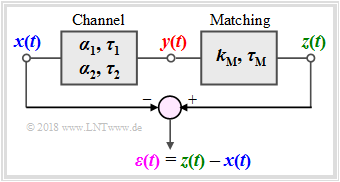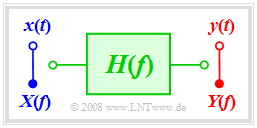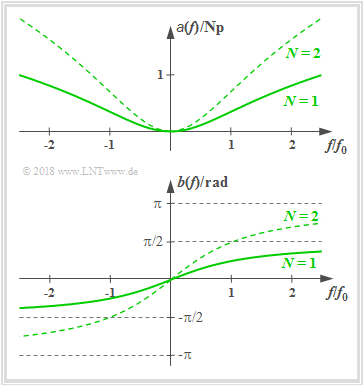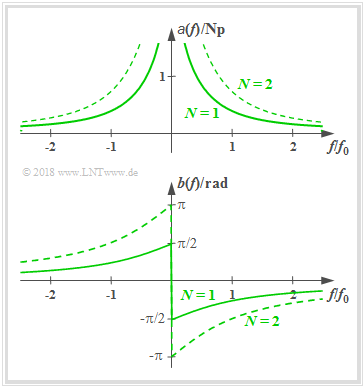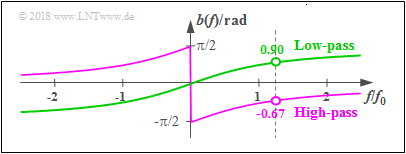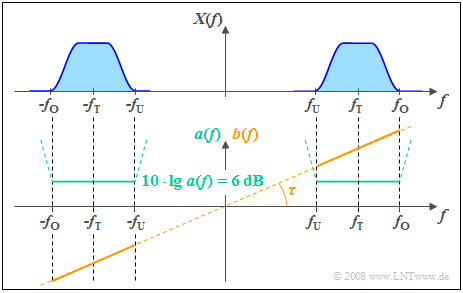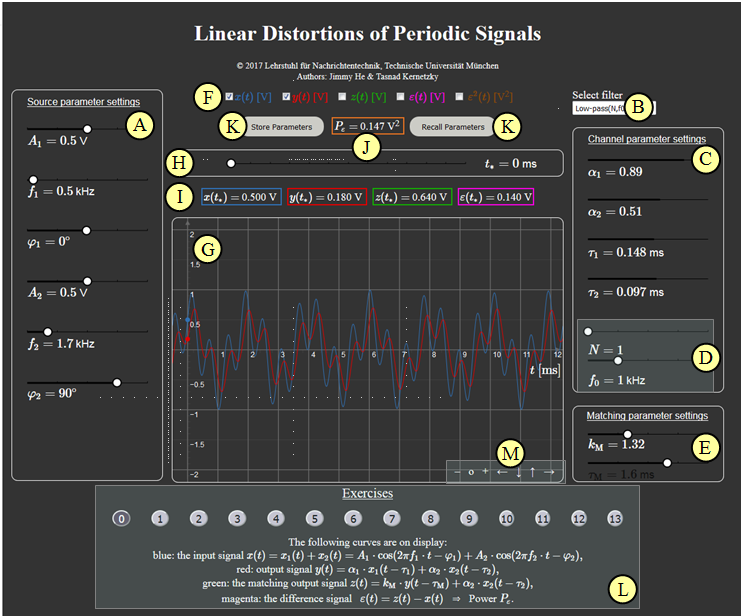Linear Distortions of Periodic Signals
Inhaltsverzeichnis
Applet Description
This applet illustrates the effects of linear distortions (attenuation distortions and phase distortions) with
- the input signal x(t) ⇒ power Px:
- x(t)=x1(t)+x2(t)=A1⋅cos(2πf1⋅t−φ1)+A2⋅cos(2πf2⋅t−φ2),
- the output signal y(t) ⇒ power Py:
- y(t)=α1⋅x1(t−τ1)+α2⋅x2(t−τ2),
- the matched output signal z(t) ⇒ power Pz:
- z(t)=kM⋅y(t−τM)+α2⋅x2(t−τ2),
- the difference signal ε(t)=z(t)−x(t) ⇒ power Pε.
The next block in the model above is Matching: The output signal y(t) is adjusted in amplitude and phase with equal quantities kM and τM for all frequencies which means that this is not a frequency-dependent equalization. Using the signal z(t), one can differentiate between:
- attenuation distortion and frequency–independant attenuation, as well as
- phase distortion and frequency–independant delay.
The Distortion Power PD is used to measure the strength of the linear distortion and is defined as:
- PD=minkM, τMPε.
Theoretical Background
Distortions refer to generally unwanted alterations of a message signal through a transmission system. Together with the strong stochastic effects (noise, crosstalk, etc.), they are a crucial limitation for the quality and rate of transmission.
Just as the intensity of noise can be assessed through
- the Noise Power PN and
- the Signal–to–Noise Ratio (SNR) ρN,
distortions can be quantified through
- the Distortion Power PD and
- the Signal–to–Distortion Ratio (SDR)
- ρD=Signal PowerDistortion Power=PxPD.
Linear and Nonlinear Distortions
A distinction is made between linear and nonlinear distortions:
- Nonlinear distortions occur, if at all times t the nonlinear correlation y=g(x)≠const.⋅x exists between the signal values x=x(t) at the input and y=y(t) at the output, whereby y=g(x) is defined as the system's nonlinear characteristic. By creating a cosine signal at the input with frequency f0 the output signal includes f0, as well as multiple harmonic waves. We conclude that new frequencies arise through nonlinear distortion.
- Linear distortions occur, if the transmission channel is characterized by a frequency response H(f)≠const. Various frequencies are attenuated and delayed differently. Characteristic of this is that although frequencies can disappear (for example, through a low–pass, a high–pass, or a band–pass), no new frequencies can arise.
In this applet only linear distortions are considered.
Description Forms for the Frequency Response
The generally complex valued frequency response can be represented as follows:
- H(f)=|H(f)|⋅e−j⋅b(f)=e−a(f)⋅e−j⋅b(f).
This results in the following description variables:
- The absolute value |H(f)| is called amplitude response and in logarithmic form attenuation function:
- a(f)=−ln|H(f)|inNeper(Np)=−20⋅lg|H(f)|inDecibel(dB).
- The phase function b(f) indicates the negative frequency–dependent angle of H(f) in the complex plane based on the real axis:
- b(f)=−arcH(f)inRadian(rad).
Low–pass of Order N
The frequency response of a realizable low–pass (LP) of order N is:
- H(f)=[11+j⋅f/f0]N.
For example the RC low–pass is a first order low–pass. Consequently we can obtain
- the attenuation function:
- a(f)=N/2⋅ln[1+(f/f0)2],
- the phase function:
- b(f)=N⋅arctan(f/f0),
- the attenuation factor for the frequency f=fi:
- αi=|H(f=fi)|=[1+(fi/f0)2]−N/2
- ⇒x(t)=Ai⋅cos(2πfit)→y(t)=αi⋅Ai⋅cos(2πfit),
- the phase delay for the frequency f=fi:
- τi=b(fi)2πfi=N⋅arctan(fi/f0)2πfi
- ⇒x(t)=Ai⋅cos(2πfit)→y(t)=Ai⋅cos(2πfi(t−τi)).
High–pass of Order N
The frequency response of a realizable high–pass (HP) of order N is:
- H(f)=[j⋅f/f01+j⋅f/f0]N.
For example the LC high pass is a first order high pass. Consequently we can obtain
- the attenuation function:
- a(f)=N/2⋅ln[1+(f0/f)2],
- the phase function:
- b(f)=−N⋅arctan(f0/f),
- the attenuation factor for the frequency f=fi:
- αi=|H(f=fi)|=[1+(f0/fi)2]−N/2
- ⇒x(t)=Ai⋅cos(2πfit)→y(t)=αi⋅Ai⋅cos(2πfit),
- the phase delay for the frequency f=fi:
- τi=b(fi)2πfi=−N⋅arctan(f0/fi)2πfi
- ⇒x(t)=Ai⋅cos(2πfit)→y(t)=Ai⋅cos(2πfi(t−τi)).
Example: This graphic shows the phase function b(f) with the cut–off frequency f0=1 kHz and order N=1
- of a low–pass (green curve),
- of a high–pass (violet curve).
The input signal is sinusoidal with frequency fS=1.25 kHz whereby this signal is only turned on at t=0:
- x(t)={0sin(2π⋅fS⋅t)(t<0),(t>0).
The left graphic shows the signal x(t). The dashed line marks the first zero at t=T0=0.8 ms. The other two graphics show the output signals yLP(t) und yHP(t) of low–pass and high–pass, whereby the change in amplitude was balanced in both cases.
- The first zero of the signal yLP(t) after the low–pass is delayed by τLP=0.9/(2π)⋅T0≈0.115 ms compared to the first zero of x(t) ⇒ marked with green arrow, whereby bLP(f/fS=0.9 rad) was considered.
- In contrast, the phase delay of the high–pass is negative: τHP=−0.67/(2π)⋅T0≈−0.085 ms and therefore the first zero of yHP(t) occurs before the dashed line.
- Following this transient response, in both cases the zero crossings again come in the raster of the period duration T0=0.8 ms.
Remark: The shown signals were created using the interactive applet Causal systems – Laplace transform.
Attenuation and Phase Distortions
The adjacent figure shows
- the even attenuation function a(f) ⇒ a(−f)=a(f), and
- the uneven function curve b(f) ⇒ b(−f)=−b(−f)
of a non–distorting channel. One can see:
- In a distortion–free system the attenuation function a(f) must be constant betweenfU and fO around the carrier frequency fT, where the input signal exists ⇒ X(f)≠0.
- From the specified constant attenuation value 6 dB follows for the amplitude response |H(f)|=0.5 ⇒ the signal values of all frequencies are thus halved by the system ⇒ no attenuation distortions.
- In addition, in such a system, the phase function b(f) between fU and fO must increase linearly with the frequency. As a result, all frequency components are delayed by the same phase delay τ ⇒ no phase distortion.
- The delay τ is fixed by the slope of b(f). The phase function b(f)≡0 would result in a delay–less system ⇒ τ=0.
The following summary considers that – in this applet – the input signal is always the sum of two harmonic oscillations,
- x(t)=x1(t)+x2(t)=A1⋅cos(2πf1⋅t−φ1)+A2⋅cos(2πf2⋅t−φ2),
and therefore the channel influence is fully described by the attenuation factors α1 and α2 as well as the phase delays τ1 and τ2:
- y(t)=α1⋅x1(t−τ1)+α2⋅x2(t−τ2).
Summary:
- A signal y(t) is only distortion–free compared to x(t) if α1=α2=α and τ1=τ2=τ ⇒ y(t)=α⋅x(t−τ).
- Attenuation distortions occur when α1≠α2. If α1≠α2 and τ1=τ2, then there are exclusively attenuation distortions.
- Phase distortions occur when τ1≠τ2. If τ1≠τ2 and α1=α2, then there are exclusively phase distortions.
Exercises
- First choose an exercise number.
- An exercise description is displayed.
- Parameter values are adjusted to the respective exercises.
- Click „Hide solution” to display the solution.
Number „0” is a „Reset” button:
- Sets parameters to initial values (when loading the page).
- Displays a „Reset text” to describe the applet further.
(1) We consider the parameters A1=0.8 V, A2=0.6 V, f1=0.5 kHz, f2=1.5 kHz, φ1=90∘, φ2=30∘ for the input signal x(t).
- Calculate the signal's period duration T0 and power Px. Can you read the value for Px off the applet?
⇒T0=[ greatest common divisor (0.5 kHz, 1.5 kHz)]−1=2.0 ms_;
Px=A21/2+A22/2=0.5 V2_=Pε, if kM=0_ ⇒ z(t)≡0.
(2) Vary φ2 between ±180∘ while keeping all other parameters from Exercise (1). How does the value of T0 and Px change?
⇒No changes:T0=2.0 ms;Px=0.5 V2_.
(3) Vary f2 between 0≤f2≤10 kHz while keeping all other parameters from Exercise (1). How does the value of Px change?
⇒No changes if f2≠0 and f2≠f1:Px=0.5 V2_.T0 changes if f2is not a multiple of f1.
If f2=0:Px=A21/2+A22=0.68 V2_.
If f2=f1:Px=[A1cos(φ1)+A2cos(φ2)]2/2+[A1sin(φ1)+A2sin(φ2)]2/2.
With φ1=90∘, φ2=30∘:Px=0.74 V2_.
(4) Keeping the previous input signal x(t), set following parameters
- α1=α2=0.5, τ1=τ2=0.5 ms, kM=1 and τM=0 .
- Are there linear distortions? Calculate the received power Py and the power Pε of the differential signal ε(t)=z(t)−x(t).
⇒y(t)=0.5⋅x(t−1 ms)_ is only attenuated and delayed, but not distorted.
Received power:Py=(A1/2)2/2+(A2/2)2/2=0.125 V2_. Pε is significantly larger:Pε=0.625 V2_.
(5) With the same settings as in Exercise (4), vary the matching parameters kM and τM. How big is the distortion power PD?
⇒PD is equal to Pε when using the ideal matching parameters:kM=2 and τM=T0−0.5 ms=1.5 ms
⇒z(t)=x(t)⇒ε(t)=0⇒PD=Pε=0_⇒Neither attenuation nor phase distortion.
(6) The channel parameters are now set to: α1=0.5,α2=0.2_, τ1=τ2=0.5 ms. Calculate the distortion power PD and the Signal-to-Distortion ratio (SDR) ρD.
⇒PD=Pε when using the best matching parameters:kM=2.24_ and τM=1.5 ms_:PD=0.059 V2_.
Attenuation distortions only.Signal-to-Distortion-Ratio ρD=Px/Pε≈8.5_.
(7) The channel parameters are now set to: α1=α2=0.5, τ1=2 ms_, τ2=0.5 ms. Calculate the distortion power PD and the the Signal-to-Distortion ratio ρD.
⇒PD=Pεwhen using the best matching parameters:kM=1.84_ and τM=0.15 ms_:PD=0.071 V2_.
Phase distortions only.Signal-to-Distortion-Ratio ρD=Px/Pε≈7_.
(8) The channel parameters are now set to: α1=0.5_,α2=0.2_, τ1=0.5 ms_, τ2=0.3 ms_. Are there attenuation distortions? Are there phase distortions? How can y(t) be approximated? Hint: cos(3x)=4⋅cos3(x)−3⋅cos(x).
⇒Both attenuation and phase distortions, because α1≠α2 and τ1≠τ2.
y(t)=y1(t)+y2(t) ⇒ y1(t)=A1⋅α1⋅sin[2πf1 (t−0.5 ms)]=−0.4 V⋅cos(2πf1t)
y2(t)=α2⋅x2(t−τ2) mit x2(t)=A2⋅cos[2πf2 (t−30∘)]≈A2⋅cos[2πf2 (t−1/36 ms)]
⇒ y2(t)=0.12 V⋅cos[2πf2 (t−0.328 ms)]≈−0.12 V⋅cos[2πf2t].
⇒ y(t)=y1(t)+y2(t)≈−0.4 V⋅[cos(2π⋅f1⋅t)+1/3⋅cos(2π⋅3f1⋅t)=−0.533 V⋅cos3(2πf1t).
(9) Using the parameters from Exercise (8), calculate the distortion power PD and the the Signal-to-Distortion ratio ρD.
Best possible adaptation:kM=1.96_, τM=1.65 ms_:PD=0.15 V2_,ρD=0.500/0.15≈3.3_.
(10) Now we set A2=0 and A1=1 V, f1=1 kHz, φ1=0∘. The channel is a Low-pass of order 1 (f0=1 kHz)_.
Are there any attenuation and/or phase distortions? Calculate the channel coefficients α1 and τ1.
At only one frequency there are neither attenuation nor phase distortions.
Attenuation factor for f1=f0 and N=1: α1=|H(f=f1)|=[1+(f1/f0)2]−N/2=2−1/2=1/√2=0.707_,
Phase factor for f1=f0 and N=1: τ1=N⋅arctan(f1/f0)/(2πf1)=arctan(1)/(2πf1)=1/(8f1)=0.125 ms_.
(11) How do the channel parameters change when using a Low-pass of order 2 compared to a Low-pass of order 1 (f0=1 kHz)?
α1=0.7072=0.5 and τ1=2⋅0.125=0.25 ms.
The signal y(t) is only half as big as x(t) and is retarded: The cosine turns into a sine function.
(12) What differences arise when using a High-pass of order 2 compared to a Low-pass of order 2 (f0=1 kHz)?
Since f1=f0 the attenuation factor α1=0.5 stays the same and τ1=−0.25 ms which means:
The signal y(t) is also only half as big as x(t) and precedes it: The cosine turns into the Minus–sine function.
(13) What differences at the signal y(t) can be observed between the Low-pass and the High-pass of order 2 (f0=1 kHz) when you start with the initial input signal according to Exercise (1) and continuously raise f2 up to 10 kHz ?
With the Low-pass the second term is increasingly suppressed. For f2=10 kHz: yLP(t)≈0.8⋅x1(t−0.3 ms).
With the High-pass however the second term dominates. For f2=10 kHz: yHP(t)≈0.2⋅x1(t+0.7 ms)+x2(t).
Applet Manual
(A) Parameter selection for input signal x(t) per slider: Amplitude, frequency, phase values
(B) Preselection for channel parameters per slider: Low-pass or High-pass
(C) Selction of channel parameters per slider: Dämpfungsfaktoren und Phasenlaufzeiten
(D) Selection of channel parameters for High and Low pass: Ordern, cut-off-frequency f0
(E) Selection of matching parameters kM and φM
(F) Selection of the signals to be displayed: x(t), y(t), z(t), ε(t), ε2(t)
(G) Graphic display of the signals
(H) Enter the time t∗ for the numeric output
( I ) numeric output of the signal values x(t∗), y(t∗), z(t∗) and ε(t∗)
(J) Numeric output of the main result Pε
(K) Save and reall parameters
(L) Exercises: Exercise selection, description and solution
(M) Variation possibilities for the graphic display
Zoom–functions „+” (scale up), „−” (scale down) und o (reset)
Move with „←” (section to the left, ordinate to the right), „↑” „↓” und „→”
'Other options:
Hold shift and scroll: Zoom in on/out of coordinate system,
Hold shift and left click: Move the coordinate system.
About the Authors
This interactive calculation was designed and realized at the Lehrstuhl für Nachrichtentechnik of the Technische Universität München.
- The original version was created in 2005 by Bettina Hirner as part of her Diploma thesis using „FlashMX–Actionscript” (Supervisor: Günter Söder ).
- In 2018 this Applet was redesigned and updated to „HTML5” by Jimmy He as part of his Bachelor's thesis (Supervisor: Tasnád Kernetzky) .
